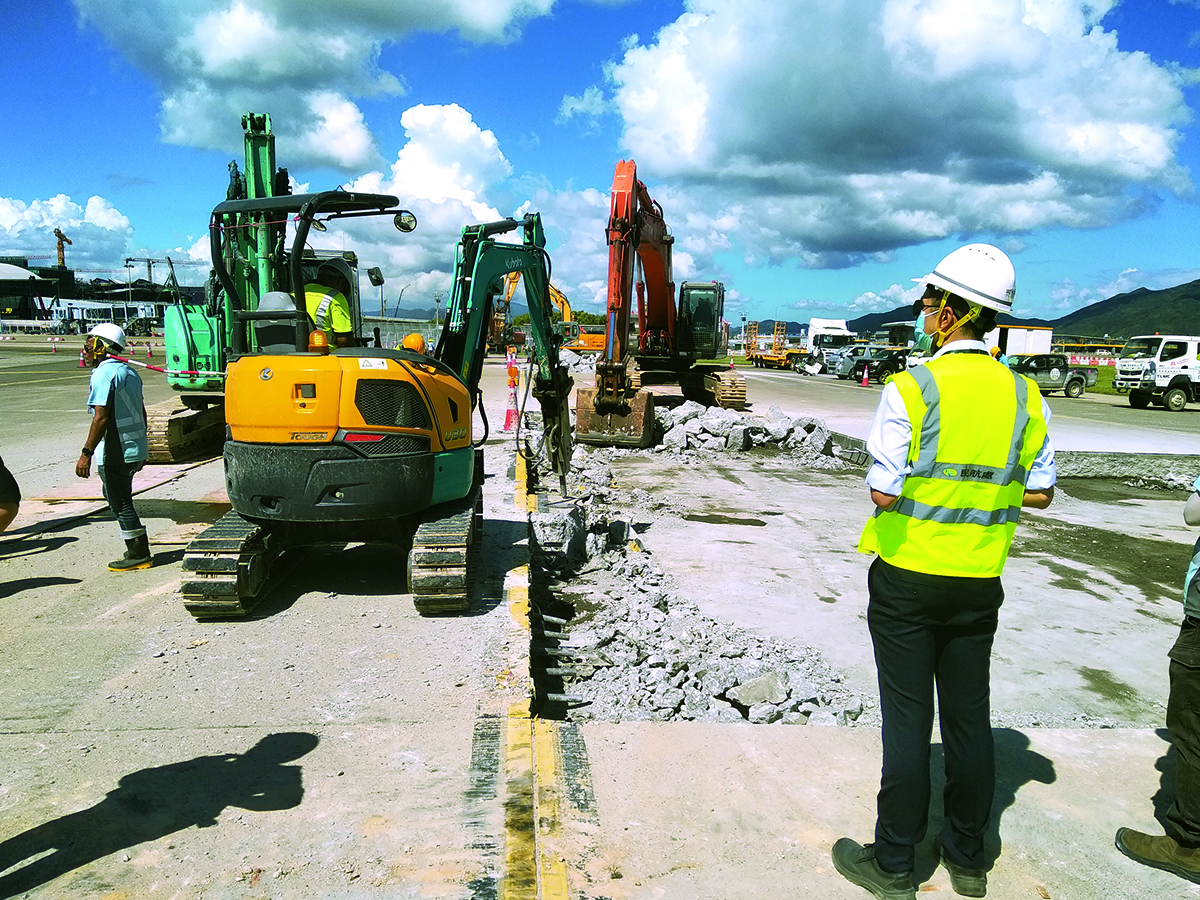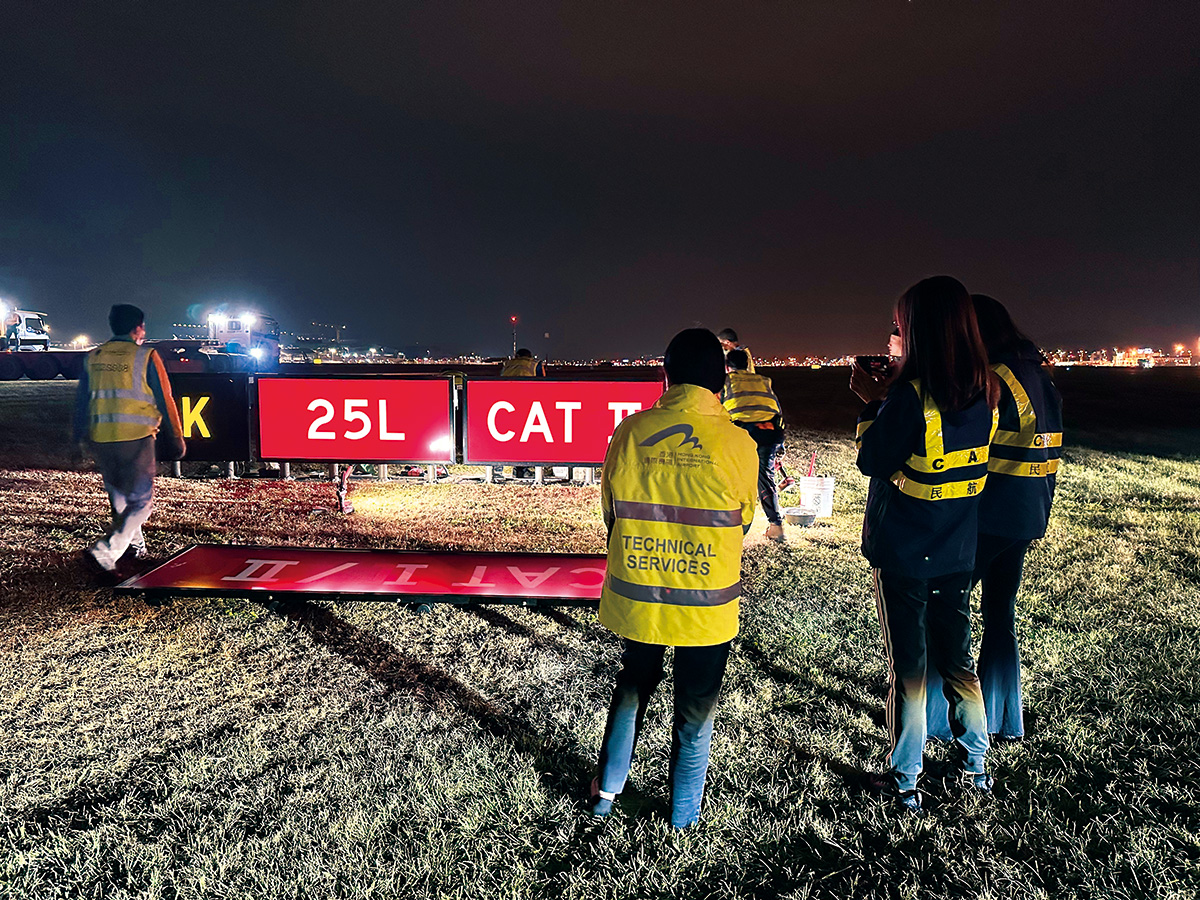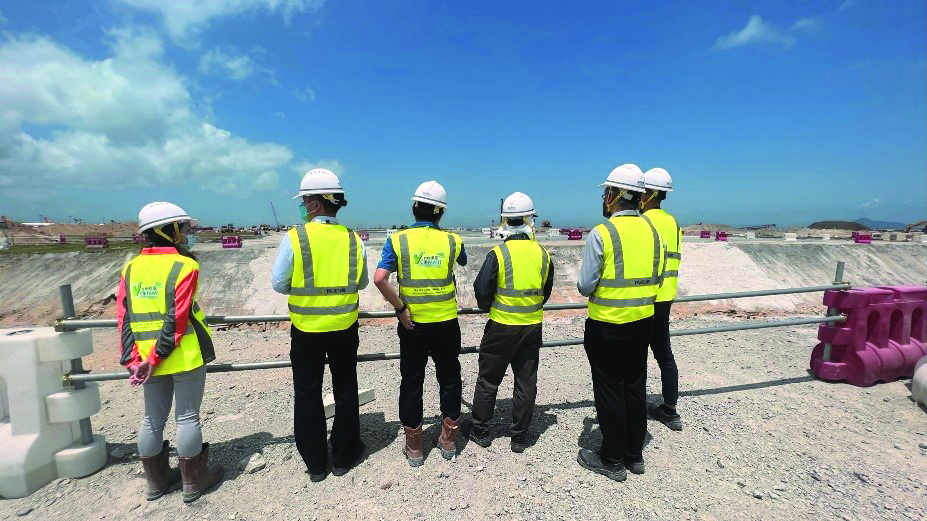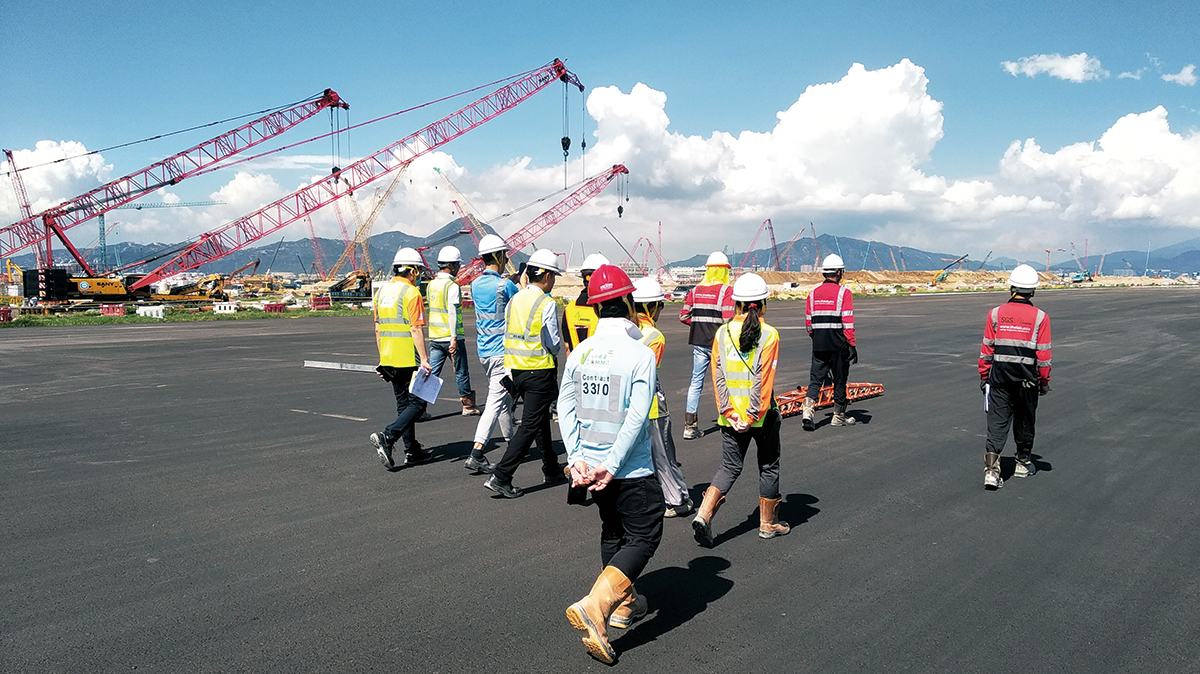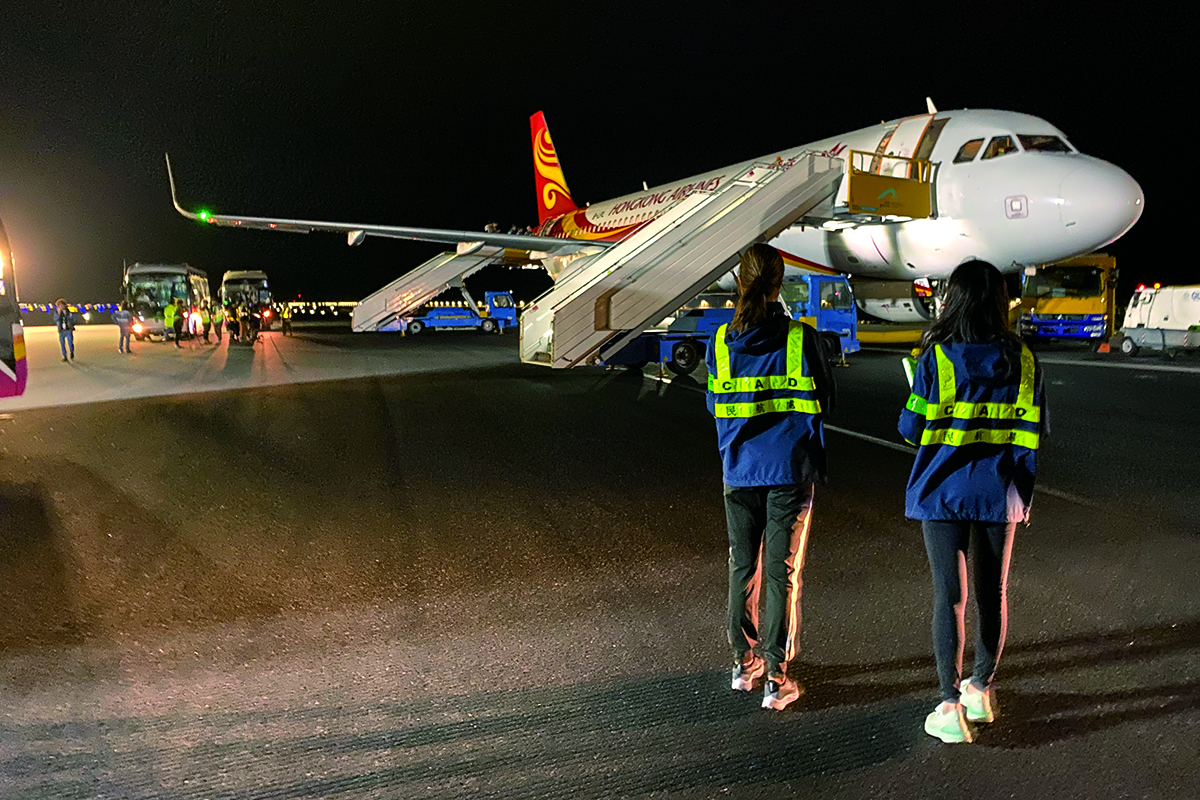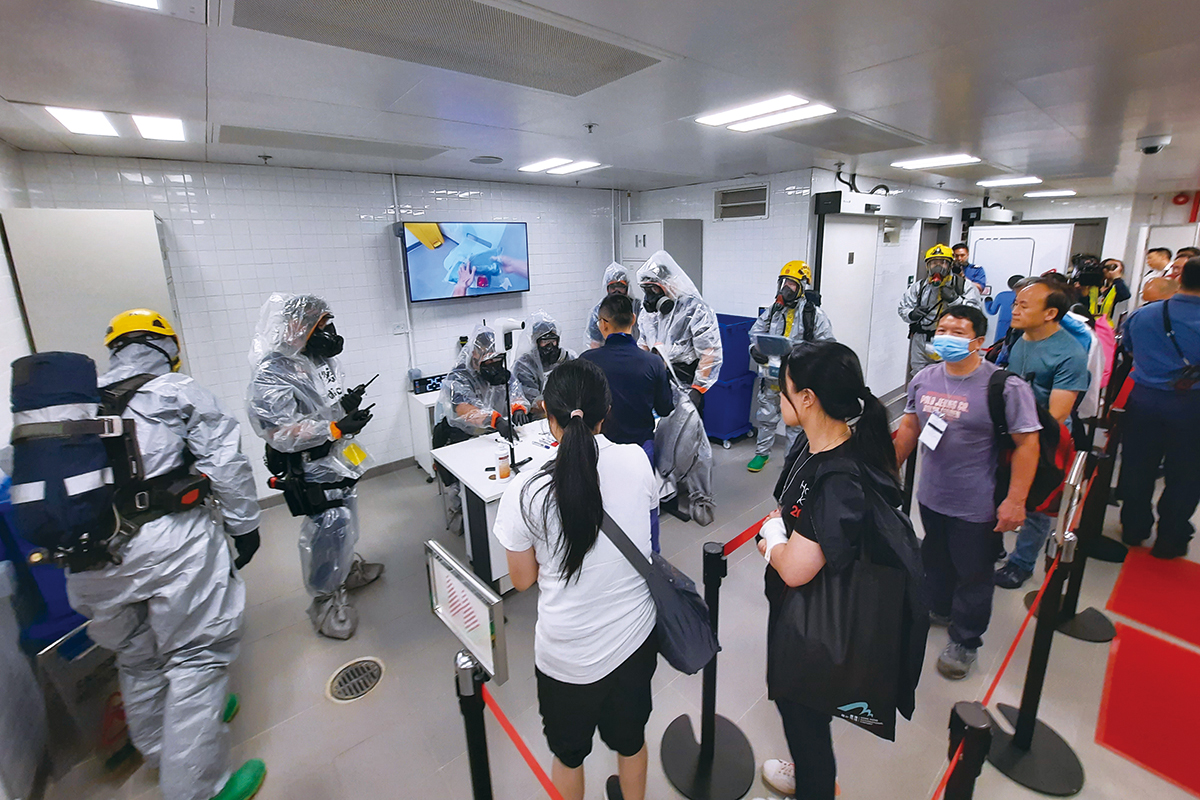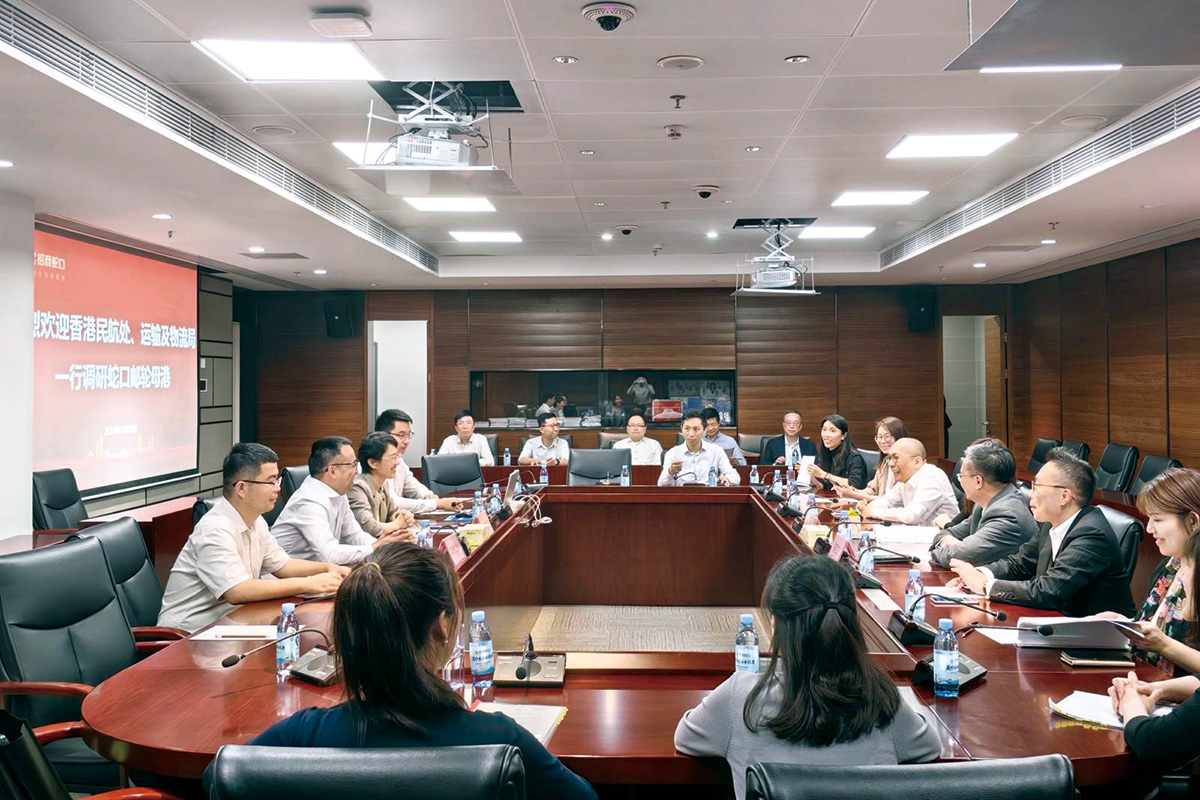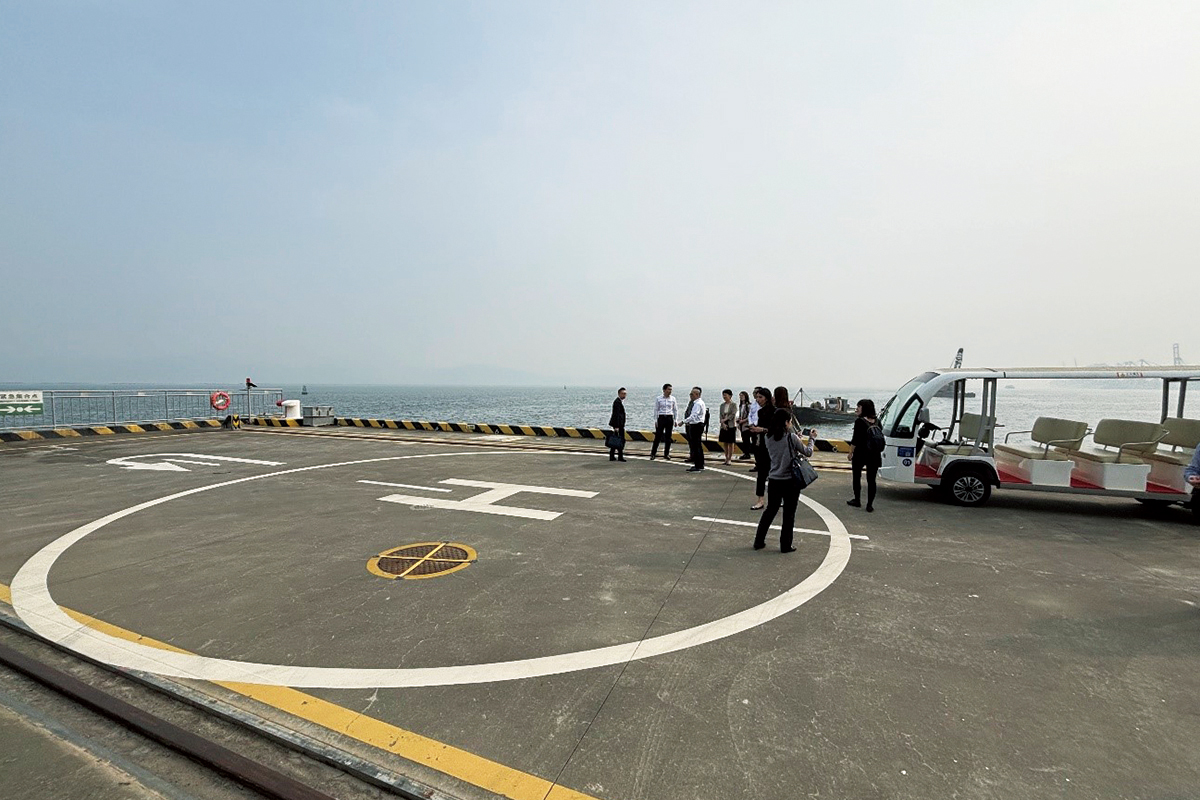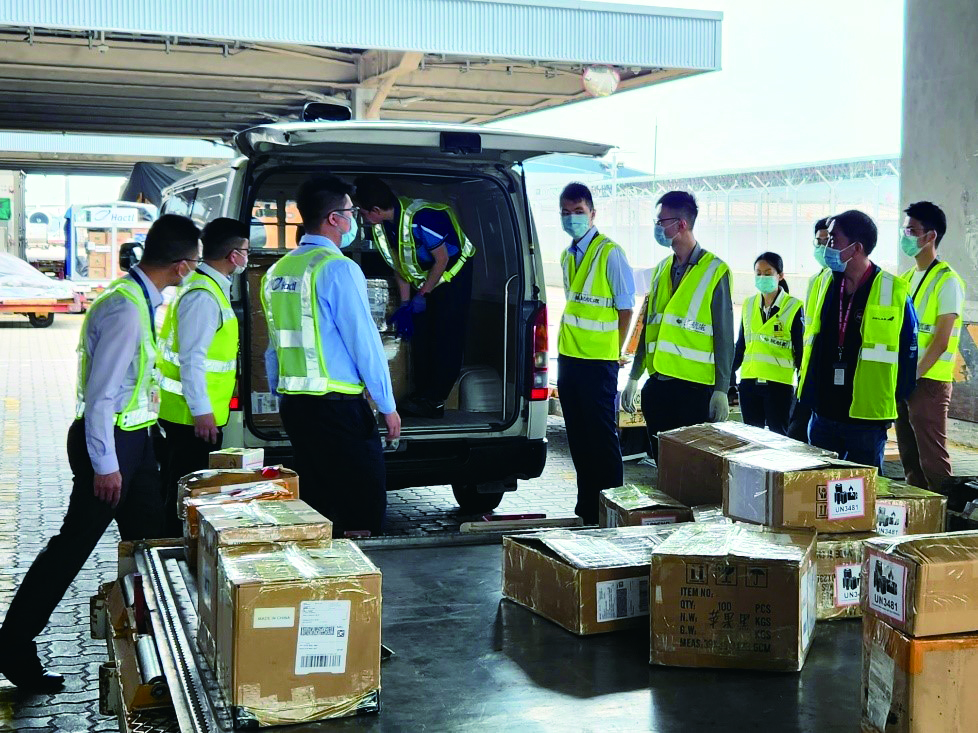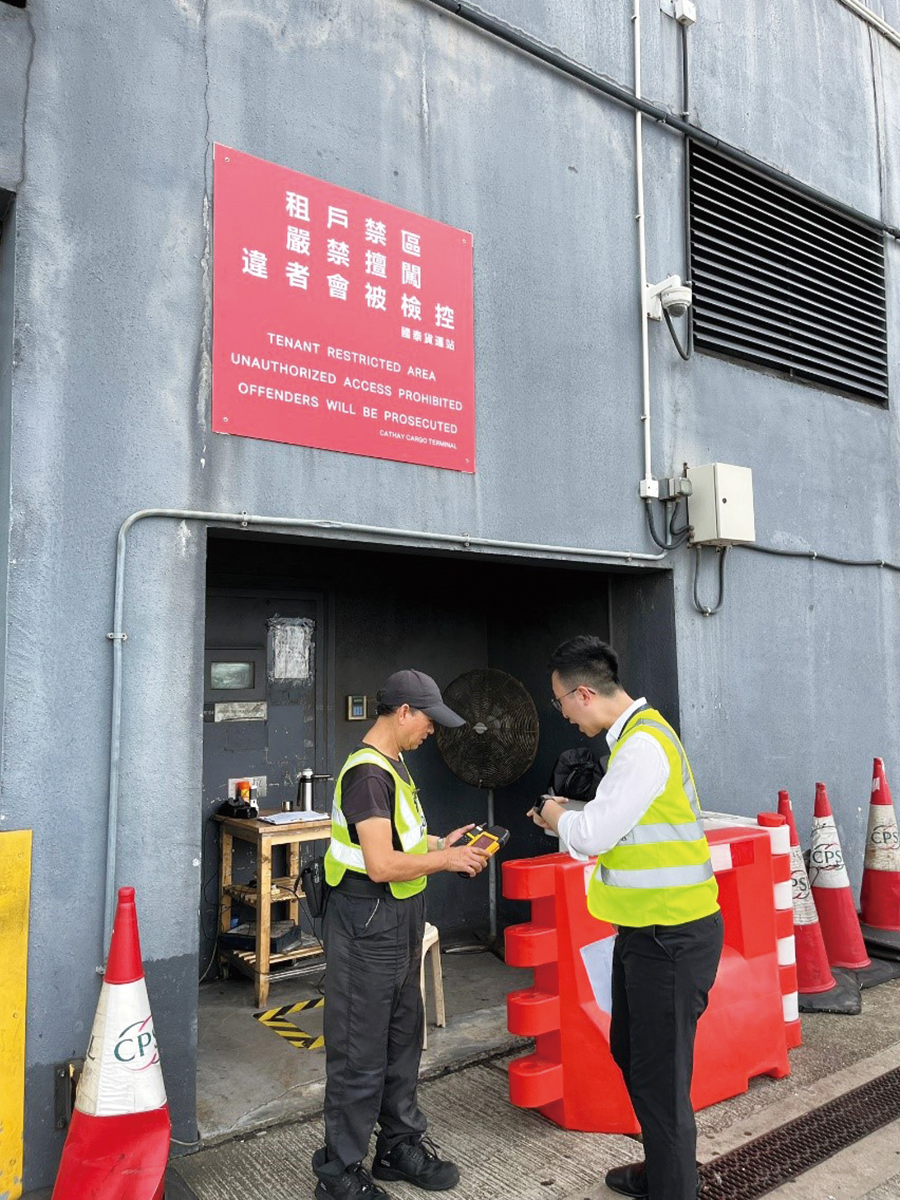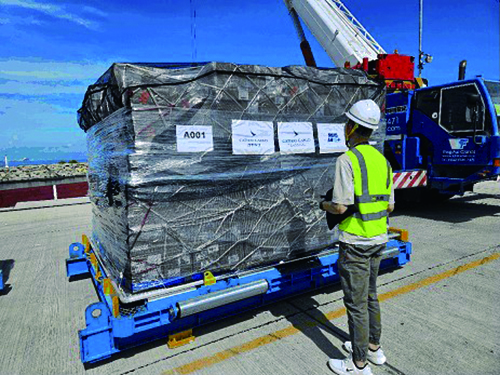The Airport Standards Division (APSD) is responsible for the regulatory functions in respect of airport safety, aviation security, control of obstructions, and safe transport of dangerous goods by air. The division also facilitates the development of heliports and cross-boundary helicopter services, monitors the safety and security of heliport operations, assesses and oversees the development and operations of the Hong Kong International Airport (HKIA) under the Interim Two-runway System (I-2RS) and the HKIA's expansion to the Three-runway System (3RS), and assumes the role in coordinating airport facilitation.
Airport Safety
Aerodrome Licensing
The Airport Authority Hong Kong (AAHK) is granted an aerodrome licence by the CAD to operate the HKIA. The APSD exercises safety oversight on the performance of the AAHK to ensure its compliance with the aerodrome licensing requirements.
The division carried out 15 audits and 117 inspections during the year covering both ad-hoc and scheduled airfield maintenance works, conditions of airfield pavements, visual aids, other facilities required for aircraft operations, implementation of the Safety Management System, emergency planning, airport rescue and firefighting services, aircraft ground operations provided by the AAHK and ground handling agents, technological applications for airport operations, as well as airfield development and enhancement projects. The division also participated in the franchisee audits carried out by the AAHK and monitored investigation of aircraft ground incidents to ensure that effective oversight was duly exercised by the AAHK on franchisees' safety performance and appropriate corrective measures had been taken by responsible parties to prevent recurrence. In view of the increase in the number of newly recruited airport operating staff amid air traffic resumption, the division closely liaised with the AAHK to monitor the safety training provided by the franchisees for such staff including those joining the industry via the "Labour Importation Scheme for the Transport Sector - Aviation Industry", with a view to enhancing safety awareness.
Throughout the year, the AAHK continued to carry out several large-scale airfield maintenance projects. Amongst others, the West Cargo Apron Development Project had been completed. All parking stands with upgrading or reconfiguration works were put into operation in May 2023. Besides, the AAHK's three-phase programme of pavement resurfacing works for the taxiways started in October 2019, with Phases 1 and 2 completed in August 2021 and December 2023 respectively. Phase 3 of the programme commenced in December 2023 and is targeted to be completed by 2026. To enhance the durability of aerodrome ground lights, the AAHK started to replace the aerodrome ground lights with LED lights. The project began in January 2019 and was scheduled for completion in the fourth quarter of 2027.
During the year, reconfiguration of the closed Centre Runway and the associated works for transitioning the HKIA from I-2RS to 3RS operations were in full swing. The division monitored the works progress and closely coordinated with the AAHK to ensure the smooth and safe transition of HKIA into 3RS operations. In the coming year, the division will conduct detailed assessments and a series of licensing inspections on the new airfield facilities, and provide regulatory advice to the AAHK in a timely manner to ascertain that such new airfield facilities are in compliance with the relevant Standards and Recommended Practices (SARPs) of the International Civil Aviation Organization (ICAO) and aerodrome licensing requirements.
With a view to testing the emergency response procedures and enhancing the coordination between the aerodrome operator and relevant responding parties when handling aircraft accidents, the AAHK conducted a number of drills and exercises throughout the year. The division actively participated in the planning meetings, provided regulatory advice to the AAHK and relevant responding parties, and conducted inspections on these drills and exercises with an aim to further enhance the emergency procedures and responses. One of them was a full-scale aircraft crash exercise held in November 2023, which simulated the rescue and fire-fighting operation for an arrival Airbus A320 aircraft with 120 people on board. The engine of the aircraft caught fire after striking the North Runway during landing. The chemicals on board leaked into the main cabin as a result of the crash, causing eye and skin irritation to passengers and the crew on board. The exercise, which was the first large-scale aircraft crash exercise conducted on the North Runway since its commissioning in 2022, provided an opportunity for different responding parties, including the AAHK, relevant government departments and the participating airline to familiarise themselves with the emergency response procedures for handling aircraft accidents and the decontamination procedures using the new Decontamination and Rescue Facility at the HKIA.
To support the development of the HKIA into a smart airport, the APSD closely liaised with the AAHK in formulating comprehensive testing, trial and implementation programmes of technological applications for airport operations. The first Autonomous Shuttle Bus for transporting airport operating staff had been in operation between Terminal 1 (T1) Midfield Concourse and the Midfield Operation and Maintenance Building since May 2023 following the successful completion of tests and trials. The Autonomous Electric Tractors cargo towing into-stand operations between the Main Cargo Apron and the designated West Cargo Apron parking stands commenced in August 2023, and the baggage towing operations were expanded between T1 Baggage Hall and parking stands of T1 Midfield Concourse in October 2023. Furthermore, remote marshalling operations supported by an upgraded Aircraft Docking Guidance System were implemented at T1 Satellite Concourse in August 2023. This allowed remote marshallers to provide marshalling guidance without being physically present at the parking bay. The APSD surveyed each process of the above trials and implementation stages, and provided regulatory advice to ensure the safety and efficiency of airport operations.
The APSD also continued to closely monitor the AAHK's aerodrome safety management activities to ensure that the safety management system at the HKIA remains robust. During the year, the division provided regulatory advice to the AAHK in the continual update process of their risk assessment register to ensure that safety risks arising from new initiatives and changes to the aerodrome environment are effectively identified and managed.
Safety Regulation
Heliport Operations and Development
The APSD kept monitoring the safety of heliport operations and providing regulatory advice on the planning and design of heliports in Hong Kong. The division has also been coordinating with stakeholders with an aim to facilitate the development of cross-boundary helicopter services between the Greater Bay Area (GBA) and Hong Kong.
The division, together with its Policy Bureau, has been liaising with the Mainland counterparts to take forward the development of cross-boundary commercial helicopter services with a view to expanding such services between Hong Kong and cities in Guangdong Province. In March 2024, representatives of the division met the related local government authorities as well as helicopter and helipad operators in Shenzhen, and visited the heliport facilities there. During the visit, the latest plans to promote cross-boundary helicopter services and the use of low-altitude airspace, amongst others, were discussed, thereby enhancing mutual understanding on the development of cross-boundary helicopter services.
Control of Obstructions
Airport Height Restrictions (AHR) are established to protect aircraft flight paths and radio navigational aids from being obstructed. The APSD assessed and provided regulatory advice on various building and development projects and feasibility studies to ensure their observance of the AHR requirements under the existing I-2RS and the forthcoming 3RS operations and other applicable aviation safety requirements. The major development projects and studies assessed during the year included the Premium Logistics Centre at Kwo Lo Wan, the expansion of the Terminal 2 (T2), the T2 Concourse, the Airport City development strategy and its associated projects including the SKYCITY developments and the automated car parks located at the Hong Kong Port of the Hong Kong–Zhuhai–Macau Bridge. In addition, regarding the AAHK's project to expand the HKIA into a 3RS, the division provided regulatory advice on the AHR requirements and the associated Marine Exclusion Zones (MEZs) for an expanded airport system in order to safeguard aviation safety of the flight paths.
As the construction works to expand the HKIA into a 3RS proceeded, a large number of working vessels and machinery were deployed by contractors to work in close proximity to the HKIA. The APSD enforced the requirement for the AAHK, its project consultants and contractors to utilise the vessel/machinery height monitoring system in checking the highest altitude of vessels/machinery working at the waters and works sites near the HKIA and enhancing the contractor's observance of the AHR requirements. This arrangement was particularly important for the division's consideration of applications for temporary AHR exemption involving high air draft vessels and tall machinery. The APSD kept a close watch on the performance of contractors in observing the AHR requirements for submission and implementation of corresponding improvement measures as and when necessary. The division also participated in various meetings with the AAHK's project consultants and contractors, and offered regulatory advice from time to time to ensure that the construction methods including the choice of construction plants would fully comply with the AHR requirements.
This year, the division issued 234 temporary AHR exemptions for the construction works in the city and vessel operations in the vicinity of the Airport Island, of which 185 were associated with the reclamation and land-based works for the expansion of the HKIA into a 3RS, and the remaining 49 issued to other works projects or one-off operations.
With the considerable assistance of the Marine Department (MD), the APSD continued to ensure integrity of the MEZs established in the vicinity of the Airport Island to safeguard the operation of aircraft and radio navigational aids. During the year, eight prosecutions against illegal entry into the MEZs were instituted by the MD.
Prohibition of Lights Endangering Aircraft Operations
To safeguard aviation safety from being compromised, the APSD kept overseeing and giving regulatory advice on the use of lasers, search lights and firework displays at different shows such as "A Symphony of Lights" as well as other lighting displays at building facades, especially illuminated advertisement signs.
General Aviation Activities
The APSD continued to monitor the safety of recreational aviation activities, including paragliding, kite flying and non-power driven model aircraft operations, to ensure that these activities were conducted in adherence to applicable aviation safety regulations and would not affect civil aircraft operations.
Carriage of Dangerous Goods
The Dangerous Goods Office (DGO) of the APSD regulates the transport of dangerous goods by air based on ICAO and local legal requirements. The DGO has established a dangerous goods permission system whereby an airline which satisfies all pertinent safety requirements will be granted a permission to carry dangerous goods to, from or over Hong Kong. During the year, six new and 50 renewal applications for dangerous goods permissions were processed. At the end of March 2024, 140 airlines have been granted permissions. The office also approved 42 organisations for conducting dangerous goods training programmes for airlines, aviation security service providers, air cargo terminals, freight forwarders and shippers. The DGO conducted regular and ad-hoc inspections to airlines, air cargo terminals, freight forwarders, shippers and training organisations to ascertain their compliance with the safety requirements on air transport of dangerous goods. For any non-compliance identified during inspections, the concerned entities were required to submit and implement corrective action plans to the CAD's satisfaction to prevent recurrence.
Promulgation of Safety Requirements
To enhance the awareness of the industry and the public of the safety requirements on air transport of dangerous goods, the DGO sustained its efforts to promulgate the safety requirements through various means. During the year, the DGO published circulars and posters, reviewed and updated the Department's website, promoted safety requirements on air transport of dangerous goods when replying enquiries, and constantly reminded the industry to abide by the relevant safety requirements. In addition, the DGO issued four advisory circulars to the airlines and air cargo industry during the year on matters concerning dangerous goods carried by passengers and safe handling and transport of lithium battery consignments.
Legislation
To align the two sets of relevant local legislation with the latest requirements of ICAO Technical Instructions for the Safe Transport of Dangerous Goods by Air, the DGO continued to take forward the related legislative amendment process during the year with the support of the air cargo industry. The legislative amendments, which primarily included updates to some technical requirements on the classification, packing, marking and labelling of certain dangerous goods for carriage by air, came into force on 30 June 2023.
Dangerous Goods Incidents
The incidents which occurred in the year were mainly related to undeclared dangerous goods in air cargo. The DGO conducted investigations into all these incidents to prevent recurrence. The CAD has also been taking prosecution actions against the entities concerned that were found contravening the dangerous goods legislation. In close cooperation with the air cargo industry, the implementation of the enhanced control, surveillance and inspection measures for safe transport of dangerous goods by air forged ahead with its regulatory efforts in managing undeclared and misdeclared dangerous goods occurrences. In addition, useful incident information was disseminated to the air cargo industry in Hong Kong and other aviation authorities.
Aviation Security
Security Oversight of Operators at HKIA and HKIA's Off-airport Facilities
To ensure compliance with the requirements of the Hong Kong Aviation Security Programme, the APSD conducted a series of security oversight activities throughout the year. Central to our efforts are security audits and inspections conducted on operators in the HKIA and its off-airport passenger, baggage and cargo processing facilities, including the AAHK, tenant restricted area operators, aircraft operators, and aircraft catering supplies and stores operators, etc.
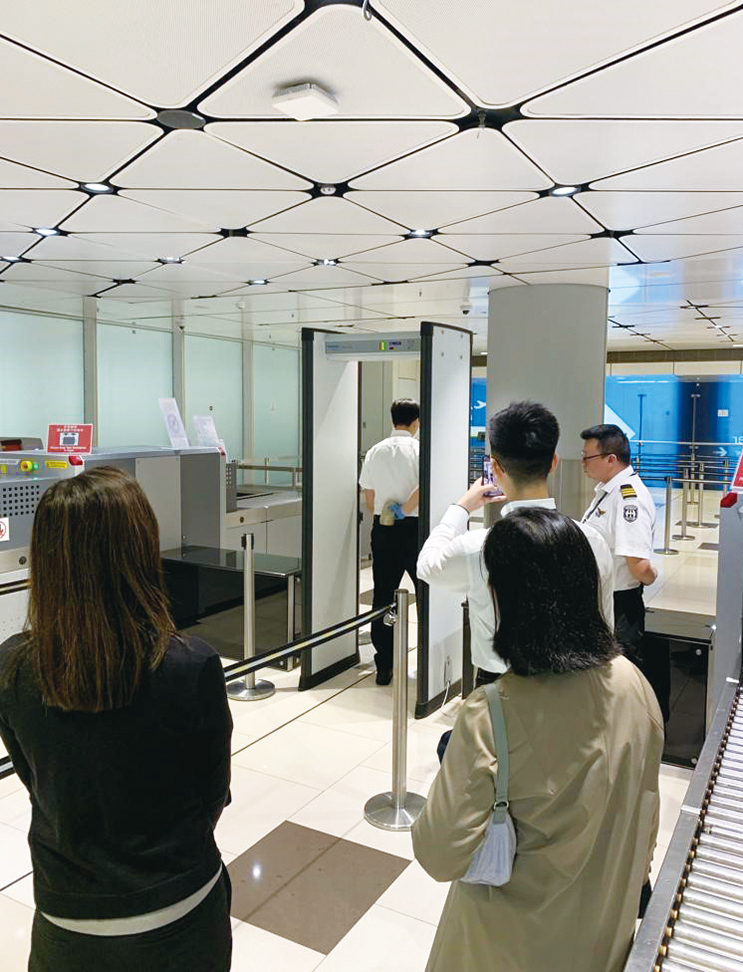
APSD officers inspected the security screening for transfer passengers at T1 Midfield Concourse of the HKIA.
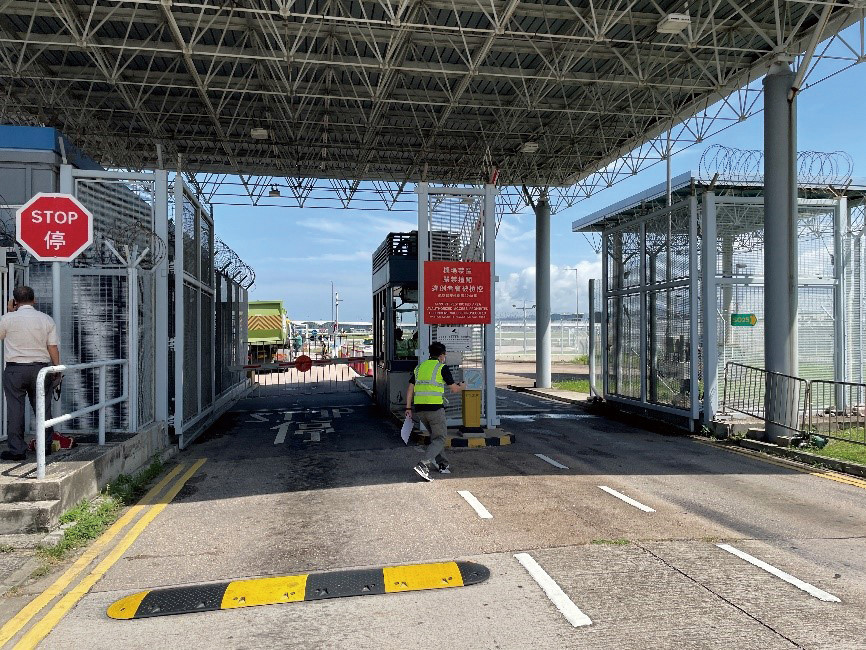
An APSD officer inspected the vehicle access control arrangement of the Enhanced Security Restricted Area of the HKIA.
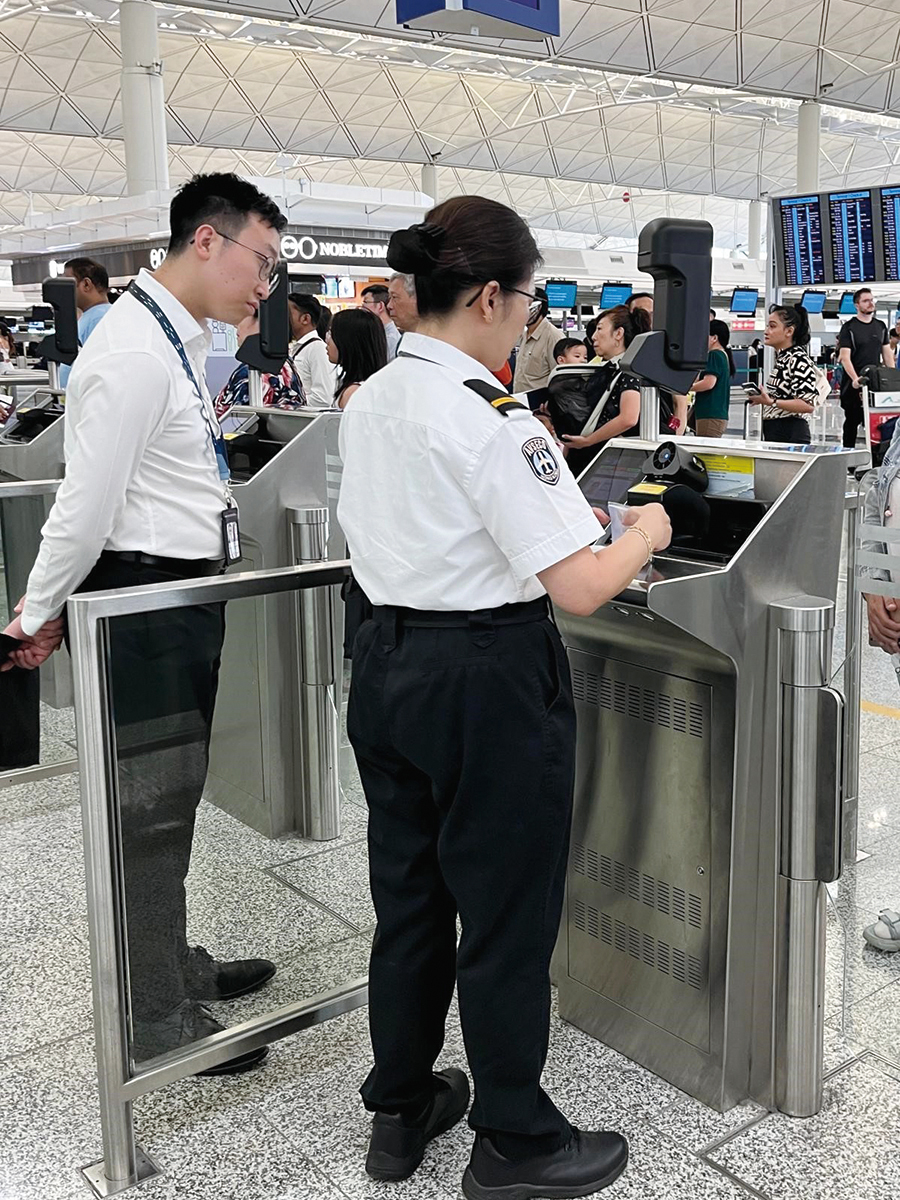
An APSD officer inspected the identify verification of departure passenger before entering the Airport Restricted Area of the HKIA.
HKIA Developments
During the year, the division processed six proposals for restricted area re-designations of the HKIA under the Aviation Security Ordinance. The re-designations included the construction of (1) the connection between the HKIA Automated People Mover (APM) Depot and Lead-in Tunnel, (2) the New Ground Services Equipment Maintenance Facility, (3) the Eastern Vehicular Tunnel extension, (4) Security Gate House B, (5) the APM tunnel at Terminal 2 Level 1, and (6) the Western Vehicular Tunnel extension and the Hong Kong Air Cargo Terminals Limited's Cool Chain Complex. The division conducted on-site assessments to confirm that adequate security control measures were in place to protect the re-designated restricted areas. The division also worked with the AAHK on 3RS-related projects, the deployment of autonomous vehicles with video analytics to assist with security patrols at the perimeter of the restricted area and other airport development projects, to ensure that they complied with the relevant aviation security requirements.
To strengthen the HKIA's status as an international air cargo hub, the AAHK continued to develop its pilot scheme for the Hong Kong International Airport Dongguan Logistics Park (HKIA Dongguan Logistics Park) and an airside intermodal cargo pier at the HKIA to enhance the sea-air cargo transshipment between the HKIA and the GBA. Under the scheme, export air cargo from the Mainland can be security screened, palletised and accepted for shipment at the HKIA Dongguan Logistics Park. The cargo accepted at the HKIA Dongguan Logistics Park can then be seamlessly transported by vessels to the airside intermodal cargo pier at the HKIA in a secure manner that complies with Hong Kong's air cargo security requirements for direct transfer onto departure flights without the need to repeat the security screening procedures in Hong Kong. The pilot scheme has been operating smoothly. The AAHK plans to complete the first-phase construction of the permanent facility in the HKIA Dongguan Logistics Park by the end of 2025.
Apart from the development of the HKIA Dongguan Logistics Park and an airside intermodal cargo pier at the HKIA, the AAHK continued to develop intermodal connection services between the HKIA and other cities in GBA. The new SkyPier Terminal (SPT) commenced operation in August 2023. Transfer passengers from Macao could check in their baggage and collect their boarding passes at the airline counters at the Macao Port, and then take the SPT bonded bus to SPT via the Hong Kong-Zhuhai-Macao Bridge, and proceed to the boarding gates for their departure flights via the HKIA APM. The baggage checked in at the Macao Port could also be delivered to the flight destinations directly. In December 2023, the said service had been expanded to Zhuhai.
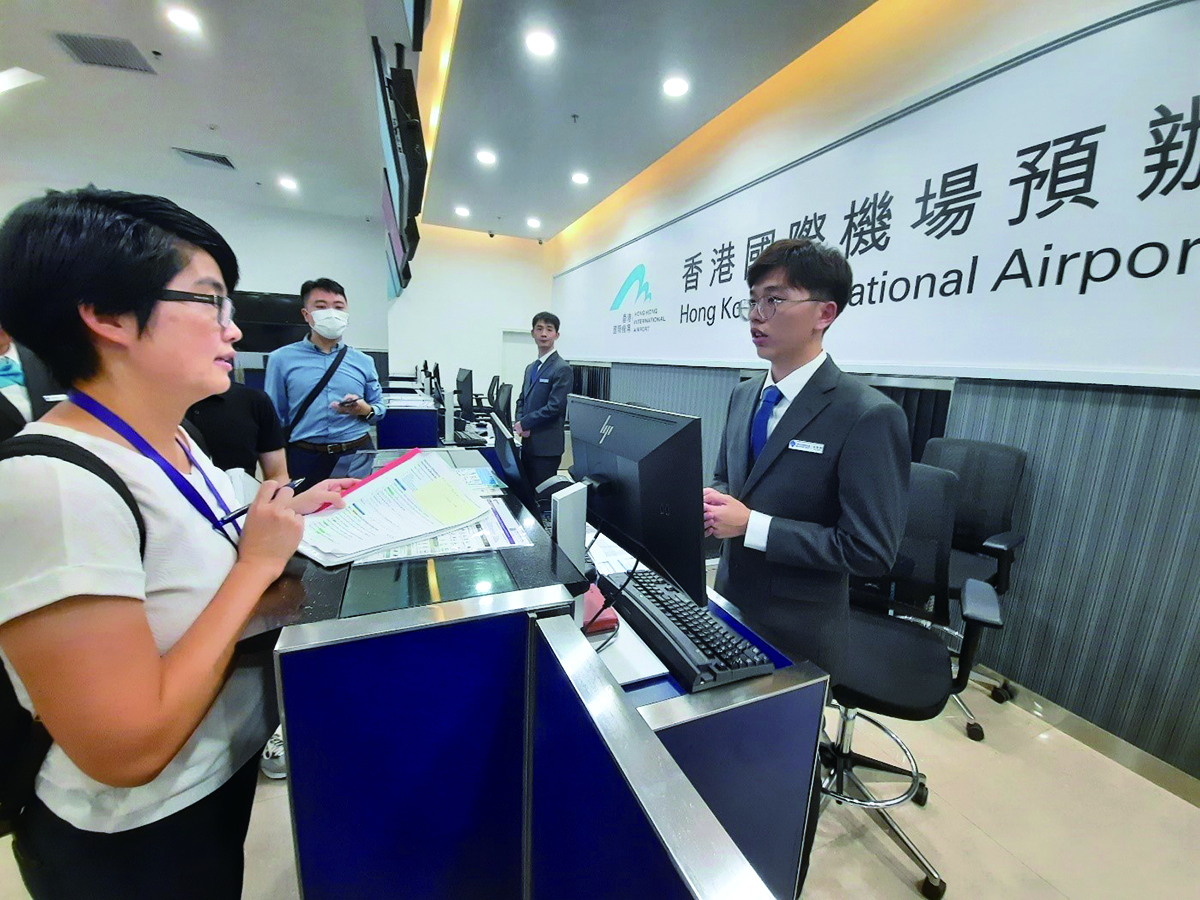
An APSD officer inspected the airline counters at the Zhuhai Port of the Hong Kong-Zhuhai-Macao Bridge.
The division will continue to closely liaise with the AAHK and provide regulatory advice on the intermodal passengers and cargo development in GBA to ensure their compliance with Hong Kong's aviation security requirements.
Air Cargo Security
Under the Regulated Agent Regime (RAR), a cargo agent registered as a Regulated Agent (RA) with the CAD is required to provide security control measures on consignments of air cargo. As at 31 March 2024, there were over 1 400 RAs registered with the CAD. The APSD kept supervising the compliance of the RAs with the requirements of RAR through regular inspections, and required them to submit and implement corresponding corrective action plans when any non-compliance was identified.
During the year, the division continued to implement the Regulated Air Cargo Screening Facility (RACSF) Scheme to facilitate air cargo screening at off-airport locations. This measure not only increases Hong Kong's overall screening capacity for export air cargo, but also enhances air cargo security through achieving 100% security screening for export air cargo. As at 31 March 2024, there were about 150 RACSFs registered with the CAD.
Facilitation
Through the Hong Kong Air Transport Facilitation Committee, the APSD continued to oversee the implementation of the SARPs of ICAO Annex 9 at the HKIA and to coordinate with senior management of relevant government departments, agencies and other organisations on facilitation activities at strategic level. The committee convened in September 2023 to discuss the coordination of orderly post-pandemic recovery of air transport services as well as the facilitation for the implementation of the "Labour Importation Scheme for the Transport Sector - Aviation Industry" to address manpower shortages in the aviation industry.
To further enhance passenger experience by giving passengers a seamless departure journey at the HKIA, the division continued to actively coordinate with the AAHK to promote the "Flight Token" service, a biometric identification system that enables passengers to complete the entire departure process – from check-in to bag drop, security checks, immigration checks and boarding, without the need to produce their boarding passes and travel documents repeatedly when they pass through various checkpoints at the HKIA. During the year, "Flight Token" was enabled at all check-in counters, as well as incorporated into the mobile apps of participating airlines, making it easier for passengers to complete the check-in process in advance and complete the self bag-drop process. The division will continue to closely liaise with the AAHK and provide regulatory advice from the angle of aviation security.
Besides, to facilitate crew members of Hong Kong registered aircraft operators in discharging their flight duties, the APSD issued Crew Member Certificates (CMCs) in accordance with ICAO Annex 9. With the recovery of air transport services, the number of CMC newly issued has increased significantly. During the year, 4 104 CMCs were issued.
International Activities
The APSD maintained close communication with overseas aviation authorities to share information on best practices of security measures for enhancing aviation security in Hong Kong, and participated in international meetings and programmes for monitoring the development of measures related to aviation security.


